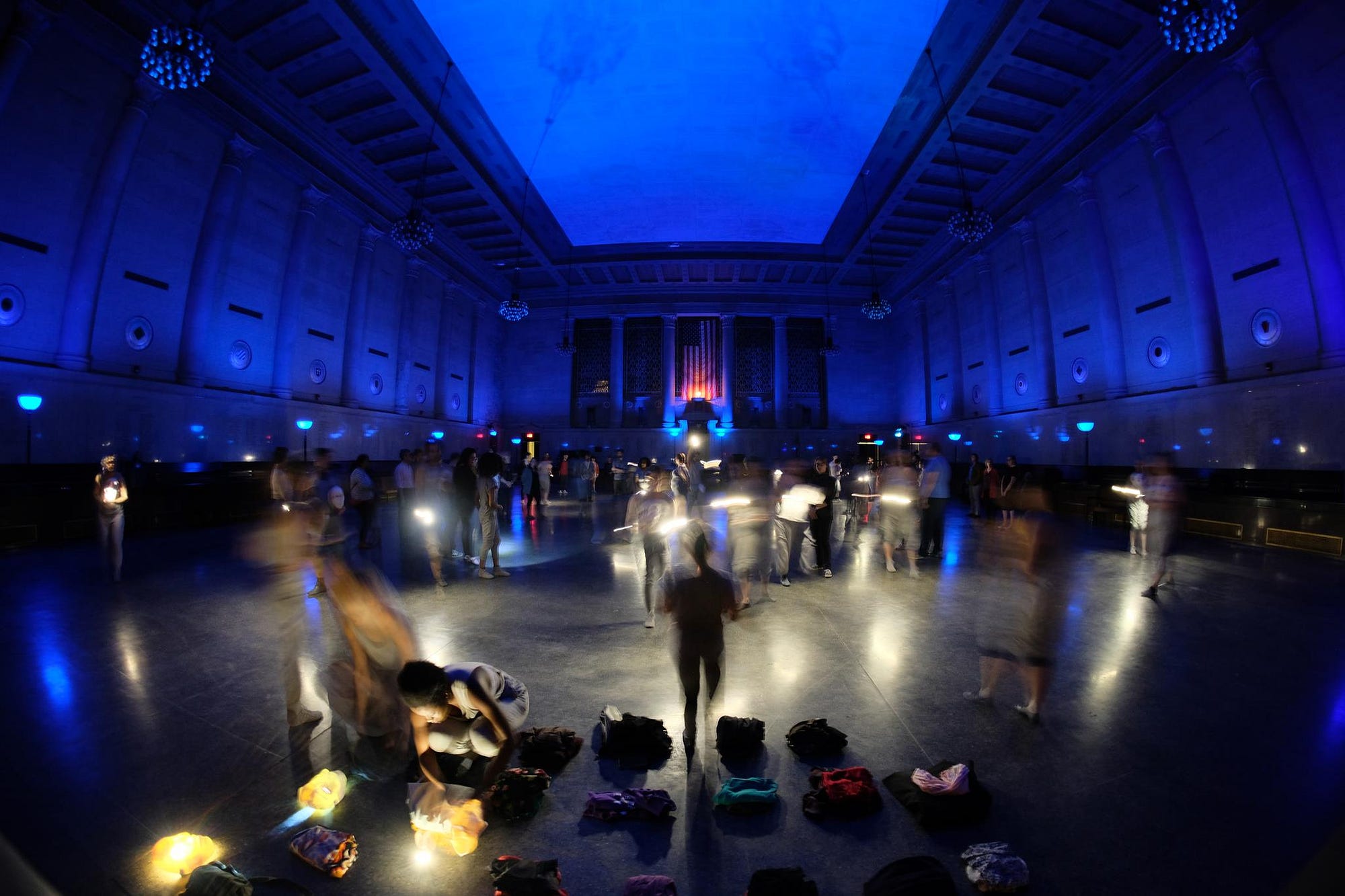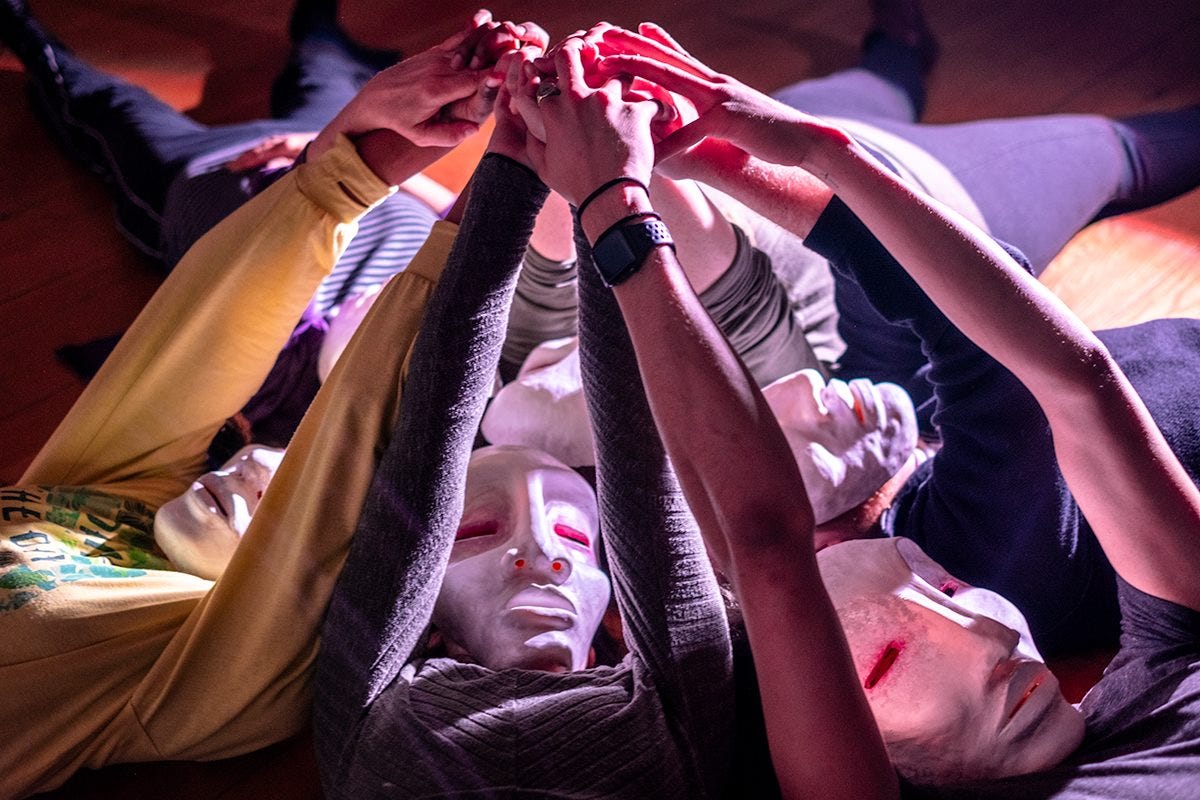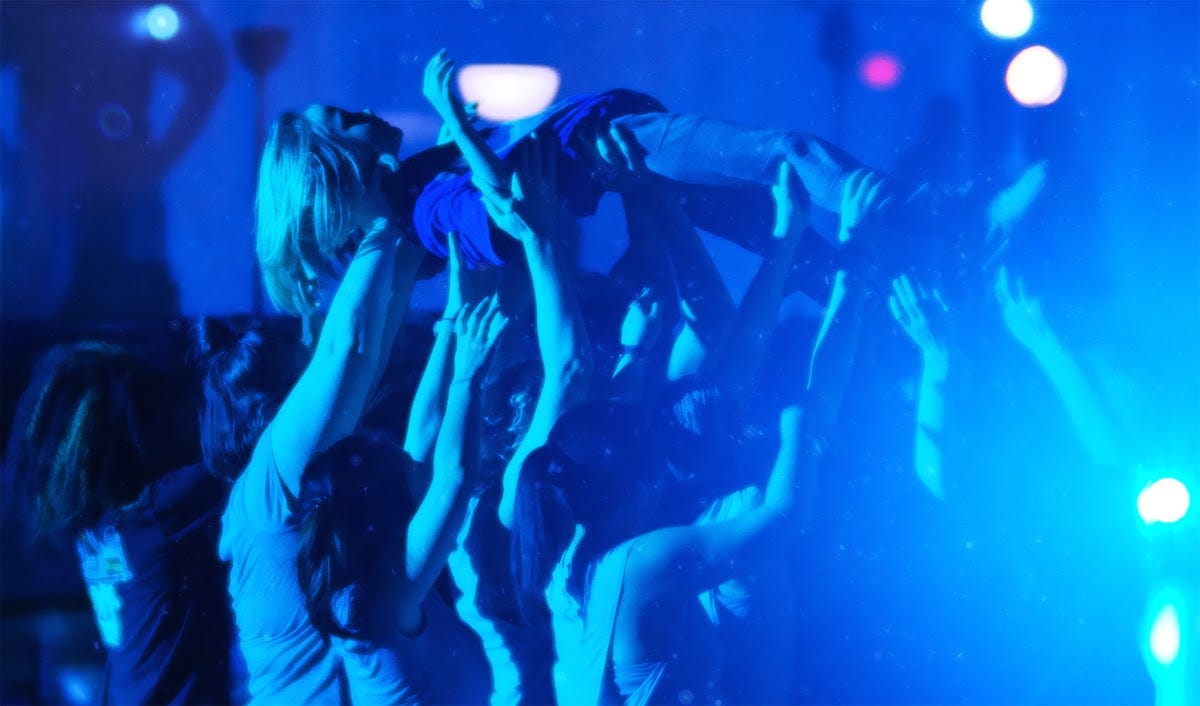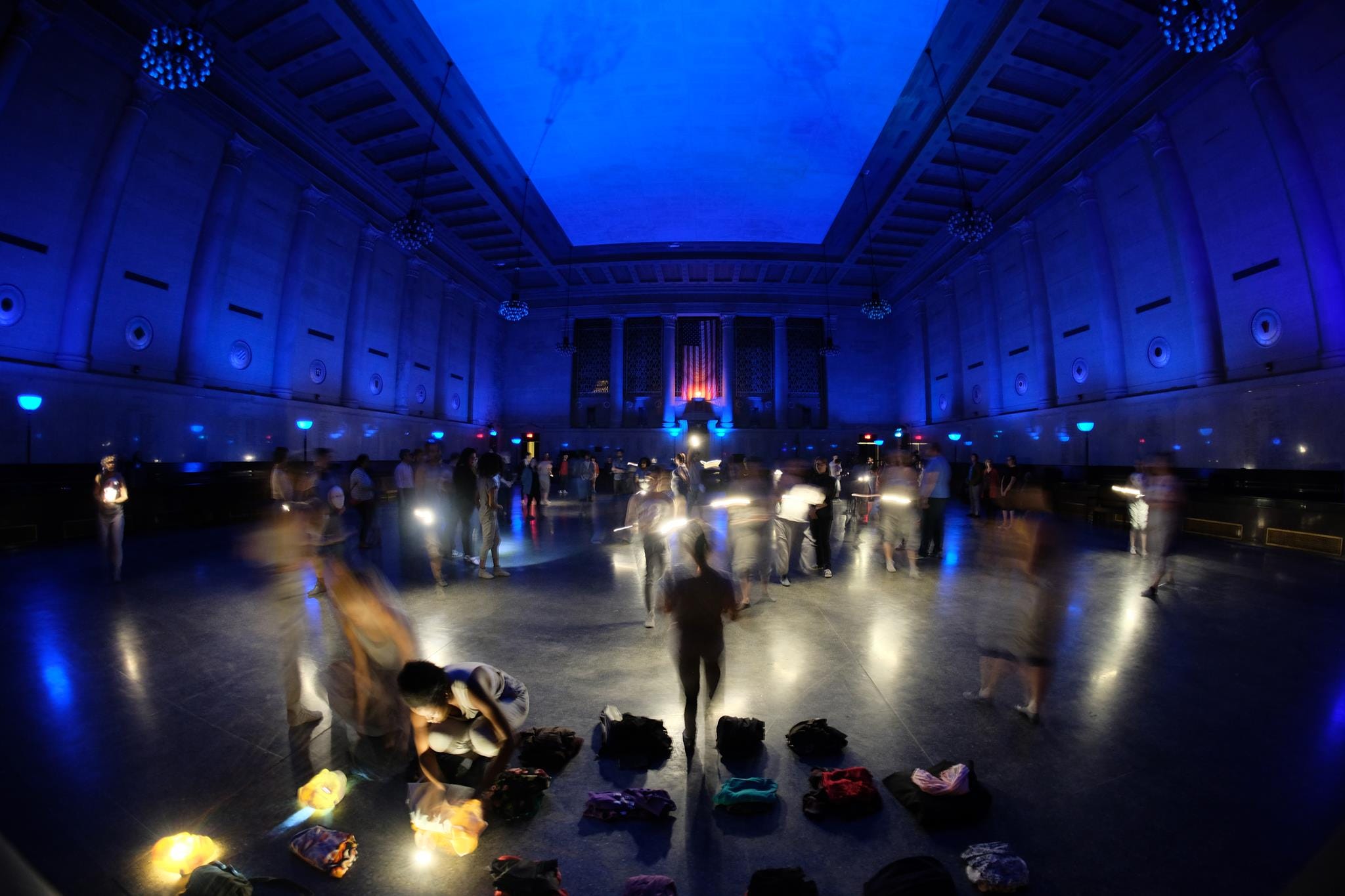
I drove a long way to see Submersive Productions’ MASS/RABBLE. As a native Marylander (born and raised), it embarrasses me to say that I live in Virginia now, so driving up to Baltimore felt like coming home. Except the venue of that night’s show, the Baltimore War Memorial Building, was a place I never bothered to visit before. I should probably be more embarrassed of that.
Being in the War Memorial Building Auditorium was an unforgettable experience: the seals of each of Maryland’s counties line the walls (I didn’t know we had seals). An eternal flame burns brightly. And artist R. McGill Mackall’s mural, “A Sacrifice to Patriotism,” majestically gazes down at you from behind tremendous columns on a balcony.
But as a venue, it’s a double-edged sword: Can the show compete? Will the performance stick in my memory as indelibly, or was it just a reason to finally go to the War Memorial?
Thanks to purposeful casting choices and plenty of smart synergy with the space, I think MASS/RABBLE does, though some sections of the hour-long, mostly word-less, 28-person, movement-based performance fizzle.
The show starts with some conflict with the space. Audience members are “processed,” which means touring the first floor’s museum, while receiving terse instructions from actors. The performers in this section are more taciturn than the wooden soldiers in the dioramas. It is hard to engage with a museum exhibit under such a robotic gaze, and it also felt like a waste of the actors’ humanity. Like the first few steps of a three-legged race, the performance and venue begin out of sync.
But once upstairs, Submersive Productions hides the plain-clothes cast amongst the audience for a long period as we wait in silence, sitting in two long rows facing each other, until the last group of audience members arrives. During this long wait and even into the first part of the show, it’s easy to get lost in trying to figure out who is a plant and who isn’t. You can only be certain after the show starts and cast members begin a segment with wordless vocalizations, which sets a strong precedent: anyone who makes a sound must be part of the cast. This teaches us, as audience members, that our role is to stay quiet, perhaps disappointingly.

Then things shift. Deana Brill’s clever costume design affords for a striking scene as the cast are processed, as if refugees or maybe conscripts. Helen Garcia-Alton’s lighting design, brilliant throughout, uses two bleak, bright lights to create two “hallways” stretching across the floor of the otherwise dark auditorium. The cast mechanically walks down these hallways, stripping off what clothing made them blend into the crowd before, all the way down to the same grey uniform underneath. From there, they pick up masks designed by Lead Artist Lisi Stoessel and fabricated by Tara Cariaso for a depiction of conflict, taking sides, crashing into each other, and flying apart like a grenade as part of Yuko Kaiseki’s movement direction. Thanks to Cariaso’s skillful handcrafting, the masks reward audience members who take the time looking for each subtle difference. Each is a pale skin tone with very small bit of color on a varying basis, accenting perhaps the eyes or the cheeks. Looking very closely, you can see how each exaggerated nose has a slightly different curve or bulb. That journey of seeming uniformity giving way to individuality is perfectly paced yet self-guided.
Get Marshall Bradshaw’s stories in your inbox
Join Medium for free to get updates from this writer.
SubscribeSubscribe
That too soon gives way; the masks and war scenes are discarded for a more meandering series of movement pieces. Here the show takes on a big challenge: changing the rules more than halfway through, as the audience is at last invited to meaningfully, audibly participate. The precedent of “cast equals noisemakers and audience is silent” that we all just practiced is a hard one to undo. Often at participatory shows, I get so into it that I am asked afterwards if I was a plant. But this time I struggled to activate and felt bad about the missed opportunity all the way home. Memorable, but probably not in the way Lead Artist Lisi Stoessel and the team intended.

But two moments in particular show how Submersive Productions have used the space beautifully. First, as a big exception to being “wordless,” one of the ensemble slips away and reappears on a balcony to sing a stirring, operatic song like a valkyrie. She stands before Mackall’s “A Sacrifice to Patriotism” while singing. So far above the “rabble” (and the “mass,” too, for that matter), she seems tiny compared to the mural — small enough to feel as though Mackall’s work were singing directly to you.
Second, during the show’s wandering third act, we all get a chance to lay down and watch Garcia-Alton’s wonderful lighting play across the ceiling. Whereas the opera drew attention to the venue instead of the show, this felt like the climax of a fireworks performance. Dark greens and purples eased across the dark ceiling, like the colors you see just after closing your eyes. Those resolved into brighter, wilder patterns and colors, reflected in the smiling faces of my fellow audience members lying down around me. Garcia-Alton had earned our undivided attention with her work throughout the show, and now she had it. For this moment, the Memorial might as well have been a white sheet.
There was one final choice made during MASS/RABBLE that deserves your attention. A quick anecdote, if you will: a while back, I was watching Submersive Productions’ previous production, H.T. Darling’s Incredible Musaeum, and loving the experience. But my mood took a hit when the show veered from a eerie but physically undemanding night in a museum to an impressive and challenging movement scene. As someone with multiple sclerosis, I’ll never forget thinking, “Oh, right, that’s why I’ll never perform in an immersive show. I can’t do that.”
It was a simplistic thought, one born of thinking that all immersive shows needed at least one large-scale movement scene. It has since been proven wrong, both by shows I’ve seen and shows I can happily say I have performed in. But it made the question so real, “who is watching this and feeling left out?” MASS/RABBLE does an astounding job fighting that feeling. Its 28-person ensemble includes a variety in body types, skin colors, genders, and ages.
It trashes the idea of immersive theatre just being a skinny, white millennial’s game.
That lesson is especially important when performing in a public space. Turning those spaces into venues needs to happen more, as it gives us a reason to remember what amazing places exist in our shared inheritance as a community. But when the theatre company benefits from that shared inheritance, it needs to be representative of the broad community it is profiting from. Seeing the people of Maryland in all our diversity invited not only to attend, but also to perform is exactly the right way to bring such a building to life.
Though I had never been to the War Memorial before or seen most of these fellow Marylanders before, I can confidently say, I felt right at home.

MASS/RABBLE continues through April 14. Tickets are $16 and up (pay what you can).
NoPro is a labor of love made possible by our generous Patreon backers. Join them today!
In addition to the No Proscenium web site, our podcast, and our newsletters, you can find NoPro on Twitter, Facebook, YouTube, Instagram, in the Facebook community Everything Immersive, and on our Slack forum.
Office facilities provided by Thymele Arts, in Los Angeles, CA.




















Discussion